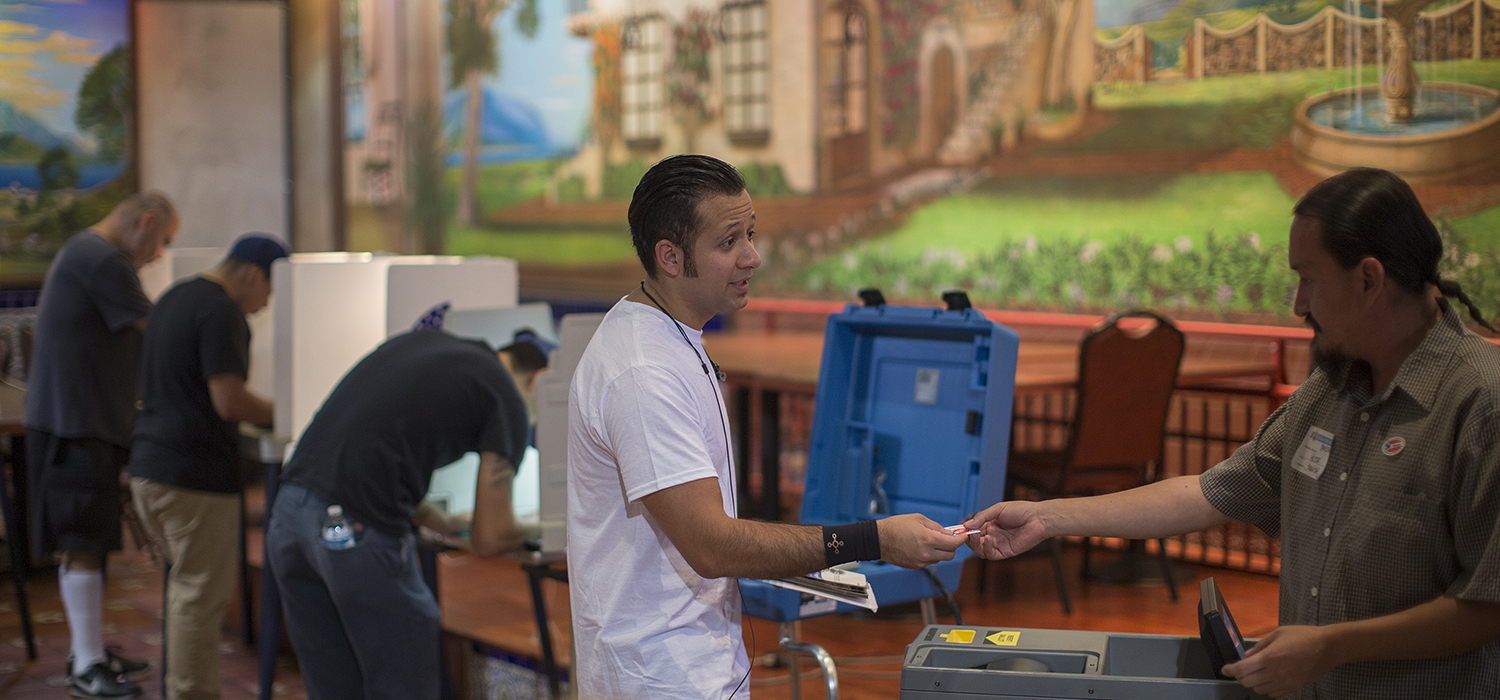
<p>Latinx Americans vote at a polling station in El Gallo Restaurant on November 8, 2016 in the Boyle Heights section of Los Angeles, California. (Photo by David McNew/Getty Images).</p>
The Latinx community—the largest minority group in the United States—plays a critical role in the US, as its voting power and voice in politics continue to grow and demand attention. But in politics and public policy, Latinx perspectives need to be more accurately represented and thoughtfully captured.
As researchers and coleaders of the Latinx Affinity Group at the Urban Institute, we recognize that conversations about Latinx communities should not only be limited to Hispanic Heritage Month or to the campaign trail. They should be ongoing as we improve how we incorporate Latinx voices into the national dialogue.
A conversation hosted by Urban’s Latinx Affinity Group and Structural Racism Project with Matt A. Barreto, a professor of political science and Chicana/o studies and cofounder of the research and polling firm Latino Decisions, highlighted research practices crucial to better communicating and incorporating a “Latinx lens” into public policy work.
1. Expand the definition of Latinx issues beyond solely immigration
Researchers and anyone engaged in public policy work need to expand the public policy conversation beyond immigration, Barreto said. Pressing issues that affect people in the United States often affect Latinx communities more acutely, but conversations on immigration dominate the Latinx policy space. Viewing immigration as the only Latinx issue creates a “single story” of the community.
All conversations, including those around homeownership, health, climate change, and education, are Latinx issues. For example, racism extends beyond immigration and is increasingly weighing on Latinxs’ minds. In a recent survey Barreto conducted, he found that after the massacre in El Paso, Texas, Latinxs are unified in concerns over racism and the threat of white supremacy in the US across all Latinx subsections—gender, age, political affiliation, and primary language.
2. Dedicate resources to representing Latinx communities accurately
For research, Barreto emphasized the importance of dedicating resources and efforts to capturing a sample large enough to represent the diversity of the Latinx community, which varies by primary language, race, generations in the US, immigration status, level of education, and culture. Researchers should be “committed to collecting large samples of Latinos and committed to doing it in a culturally appropriate, sensitive, and accurate way,” he said, adding, “the plural of a bad sample is a larger bad sample.”
At best, a single box for ethnicity simplifies the Latinx community and, at worst, is inaccurate or misrepresentative. With larger samples, research can be broken down into crosstabs, providing more than one data point for Latinxs. Barreto said, “It is critically important so that we can pivot, talk about, and serve those communities as policymakers or analysts and be able to know there are differences of opinions, and different policies may be relevant.”
Additionally, researchers need to be diligent in their methods. Are surveys offered in Spanish? What are the demographics of respondents? Are we systemically excluding people from analysis? What role can interviews play in contextualizing numbers?
3. Rely on trusted advocates and Spanish-language media for outreach
Researchers and policymakers must also bring knowledge back to Latinx communities. Relying on trusted messengers such as advocacy organizations and community-based organizations can help Latinxs access research findings that could affect their lives.
Reaching out to Latinx media is also critical. Barreto pointed out that even though Latinxs increasingly watch English-language media, they trust Spanish-language media for news. He explained that there is a sense that Spanish-language news is delivered from the perspective of advocacy and is meant to give information needed to succeed in America. Using those media and developing deep and authentic partnerships with Latinx-serving media organizations can create channels to convey important information.
Researchers and policymakers can do better to intentionally incorporate a Latinx lens into our studies and subject areas and to connect our work with the communities it directly affects through partnerships with local community-based organizations and advocates.
In practice, incorporating a Latinx lens in policy work means including breakdowns by race and ethnicity in research, going to the communities themselves to understand Latinx perspectives on policies, and hiring and promoting Latinx people to talk about, study, and report on issues that affect their communities.
As Barreto said, “We need to have these discussions through the Latino lens and have Latinos talking about them.”
Let’s build a future where everyone, everywhere has the opportunity and power to thrive
Urban is more determined than ever to partner with changemakers to unlock opportunities that give people across the country a fair shot at reaching their fullest potential. Invest in Urban to power this type of work.